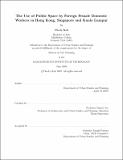| dc.contributor.advisor | Tunney Lee. | en_US |
| dc.contributor.author | Koh, Cha-ly | en_US |
| dc.contributor.other | Massachusetts Institute of Technology. Dept. of Urban Studies and Planning. | en_US |
| dc.coverage.spatial | a-cc-hk a-si--- a-my--- | en_US |
| dc.date.accessioned | 2009-11-06T14:49:02Z | |
| dc.date.available | 2009-11-06T14:49:02Z | |
| dc.date.copyright | 2009 | en_US |
| dc.date.issued | 2009 | en_US |
| dc.identifier.uri | http://hdl.handle.net/1721.1/49535 | |
| dc.description | Thesis (M.C.P.)--Massachusetts Institute of Technology, Dept. of Urban Studies and Planning, 2009. | en_US |
| dc.description | This electronic version was submitted by the student author. The certified thesis is available in the Institute Archives and Special Collections. | en_US |
| dc.description | Includes bibliographical references (p. 159-171). | en_US |
| dc.description.abstract | In globalizing cities around the world, middle class women are departing from their traditional domestic roles in child rearing and home management. This activity change creates a large influx of young, single and lower income female workers from developing nations such as the Philippines, Indonesia, Cambodia and others into Hong Kong, Singapore and Kuala Lumpur to serve as domestic workers. Because most female domestic foreign workers reside in the employers' homes, they seek a space elsewhere to meet their needs for privacy, familiarity and companionship on non-working days. As a result, there is an emerging phenomenon where large numbers of female foreign domestic workers gather in public spaces around the city to socialize and to enjoy a brief moment of privacy away from their employers. In these spaces, domestic workers form ephemeral cities. They transform public spaces by assigning areas for food consumption and production, areas to conduct recreational activities such as dancing and singing, places to exchange currencies to send back to their homes abroad and other spaces to fulfill their needs in a foreign city. Unfortunately, this phenomenon is often seen by local citizens as a form of nuisance, inconvenience or even threat, thus causing tension and sometimes conflict between locals and foreign workers. In this thesis, I carried out observation studies on FDW gathering sites in Hong Kong, Singapore and Kuala Lumpur. | en_US |
| dc.description.abstract | (cont.) Through this observation study, I found similar and different physical spatial characteristics across all three cities. Stakeholders also play varying roles in influencing the FDW gathering spaces in these cities. From this comparative study, I learned that the accommodation of FDWs in public spaces varies depending on various factors such as culture, demographics and city branding in each city. With the current exponential growth of transnational foreign domestic labor in the region and world, I hope that this study will inform sustainable humanitarian strategies in accommodating female foreign domestic workers around the world. | en_US |
| dc.description.statementofresponsibility | by Cha-ly Koh. | en_US |
| dc.format.extent | 171 p. | en_US |
| dc.language.iso | eng | en_US |
| dc.publisher | Massachusetts Institute of Technology | en_US |
| dc.rights | M.I.T. theses are protected by
copyright. They may be viewed from this source for any purpose, but
reproduction or distribution in any format is prohibited without written
permission. See provided URL for inquiries about permission. | en_US |
| dc.rights.uri | http://dspace.mit.edu/handle/1721.1/7582 | en_US |
| dc.subject | Urban Studies and Planning. | en_US |
| dc.title | The use of public space by foreign female domestic workers in Hong Kong, Singapore and Kuala Lumpur | en_US |
| dc.type | Thesis | en_US |
| dc.description.degree | M.C.P. | en_US |
| dc.contributor.department | Massachusetts Institute of Technology. Department of Urban Studies and Planning | |
| dc.identifier.oclc | 436280617 | en_US |
